
Posted on 04/25/2015 5:02:04 AM PDT by Homer_J_Simpson


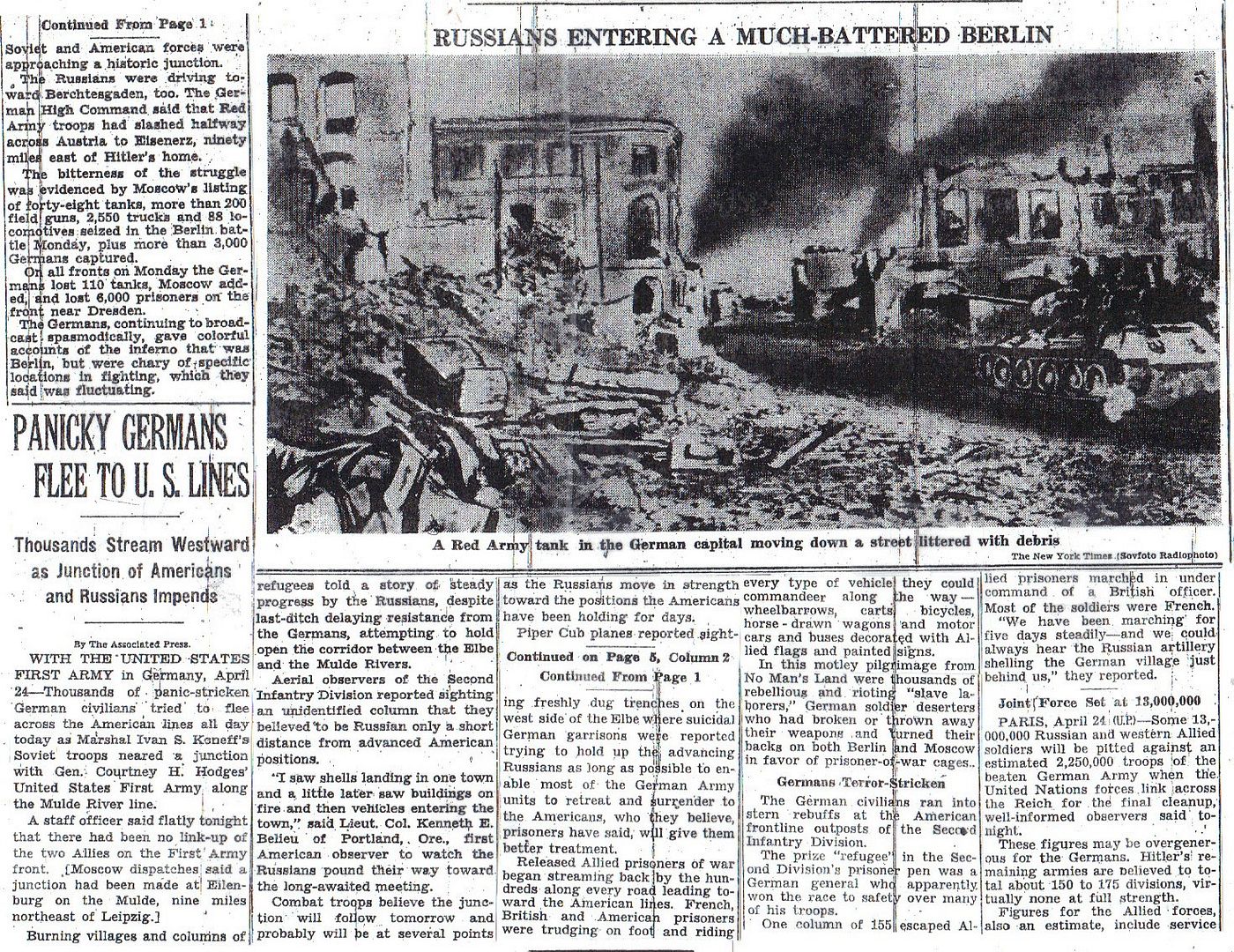
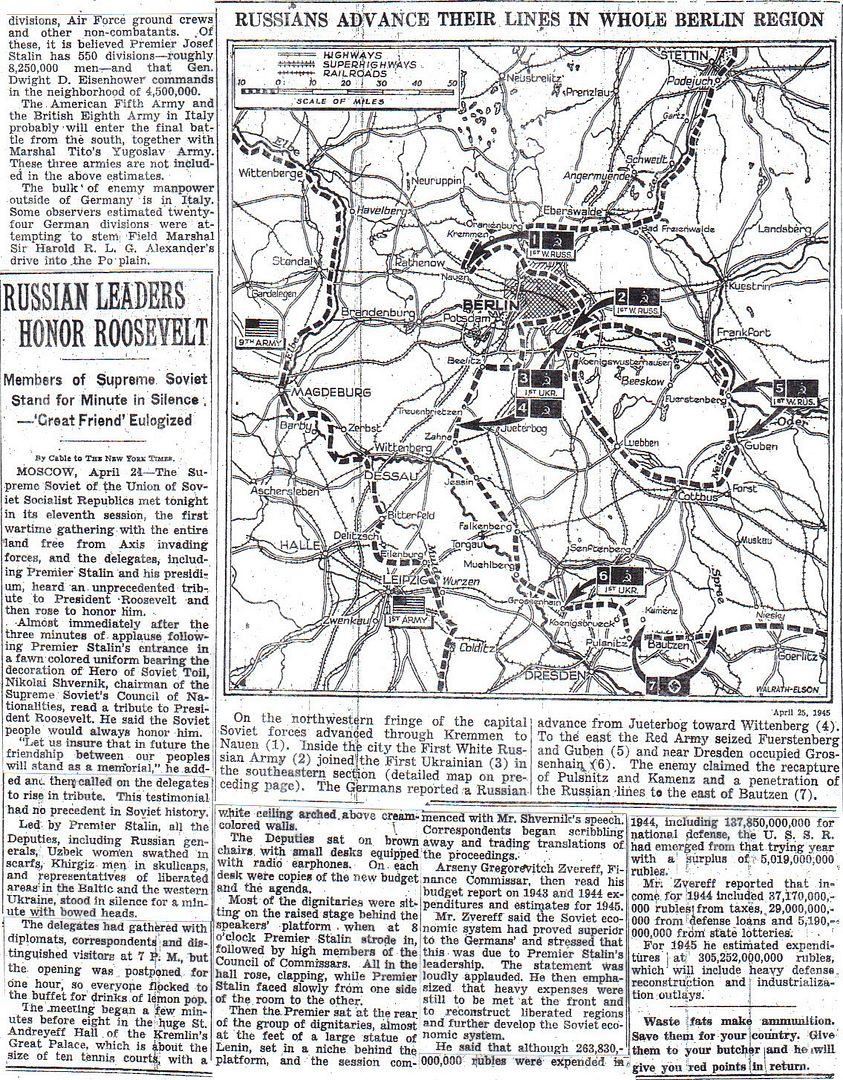
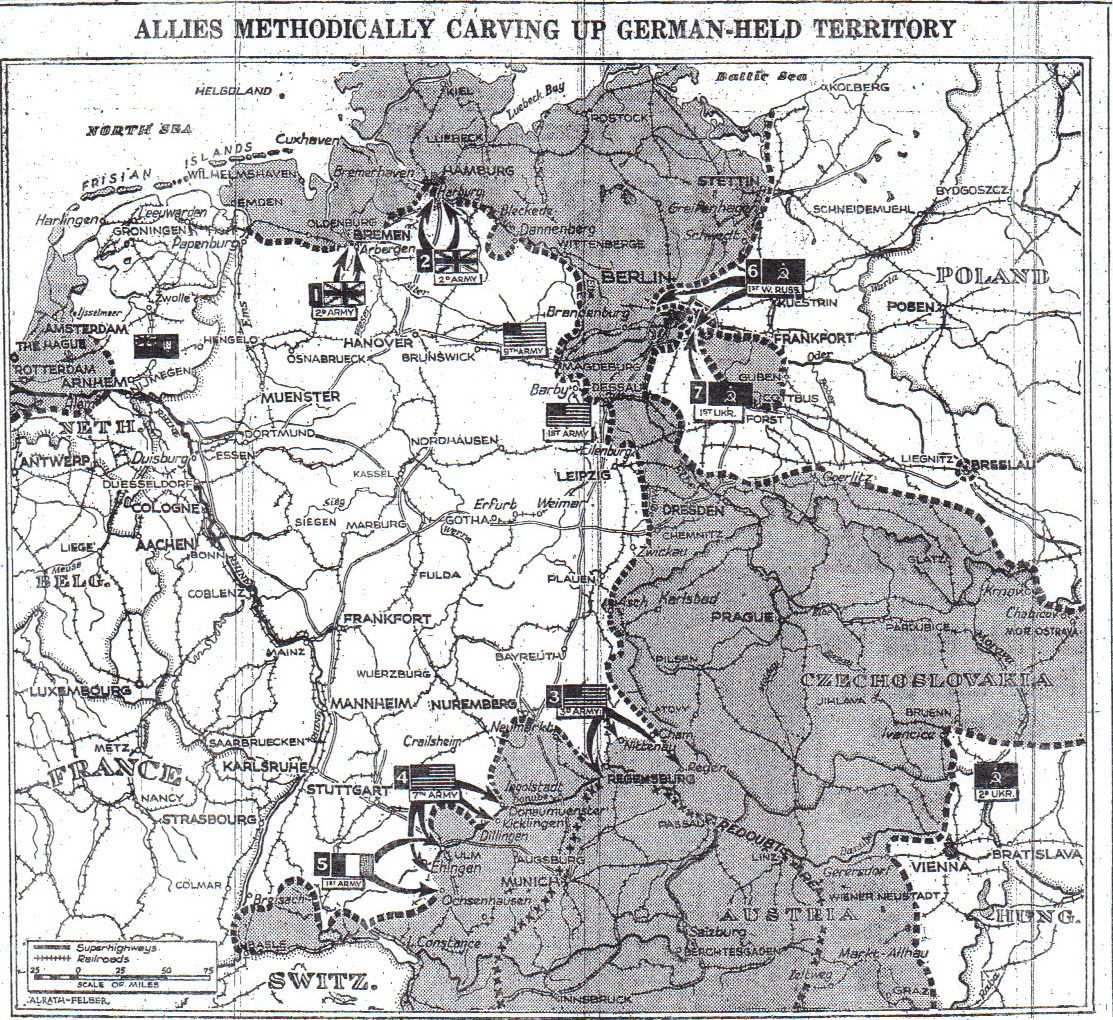
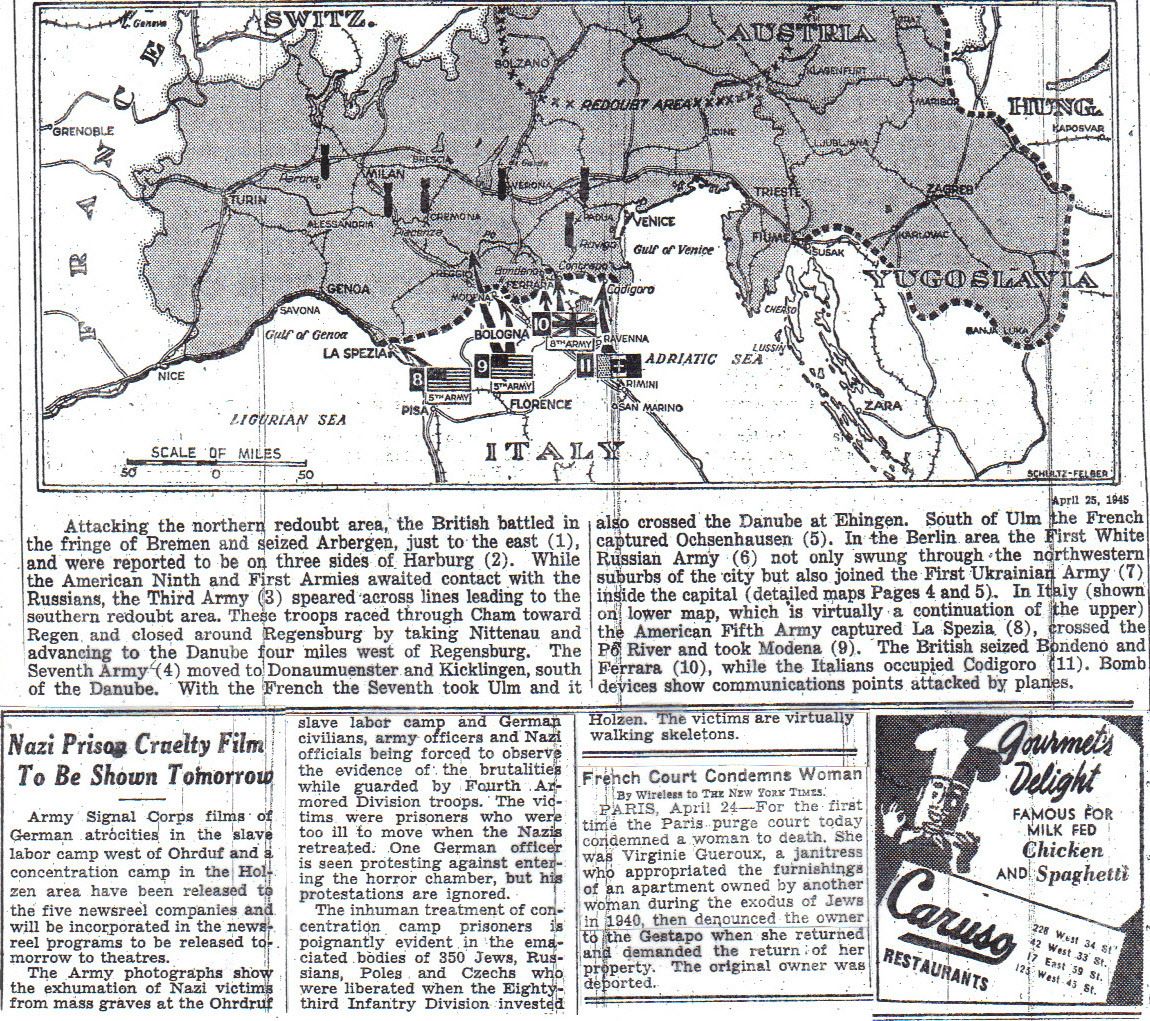
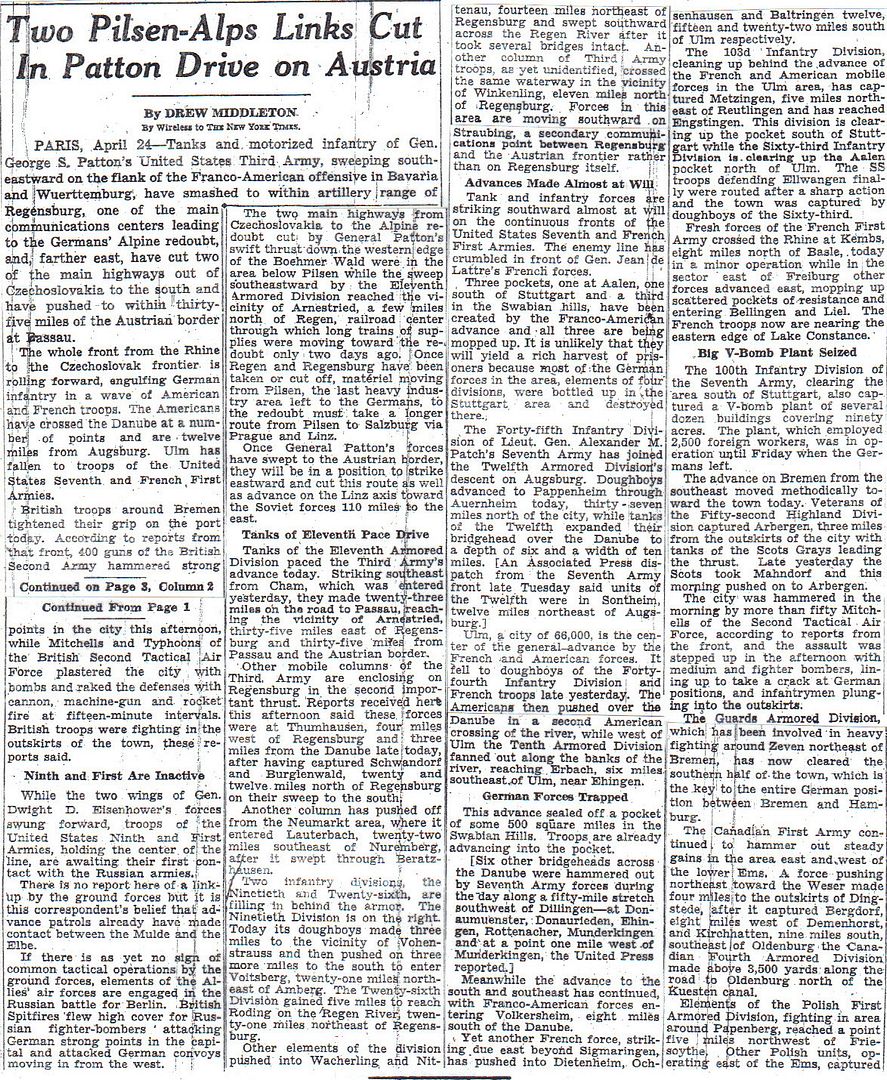
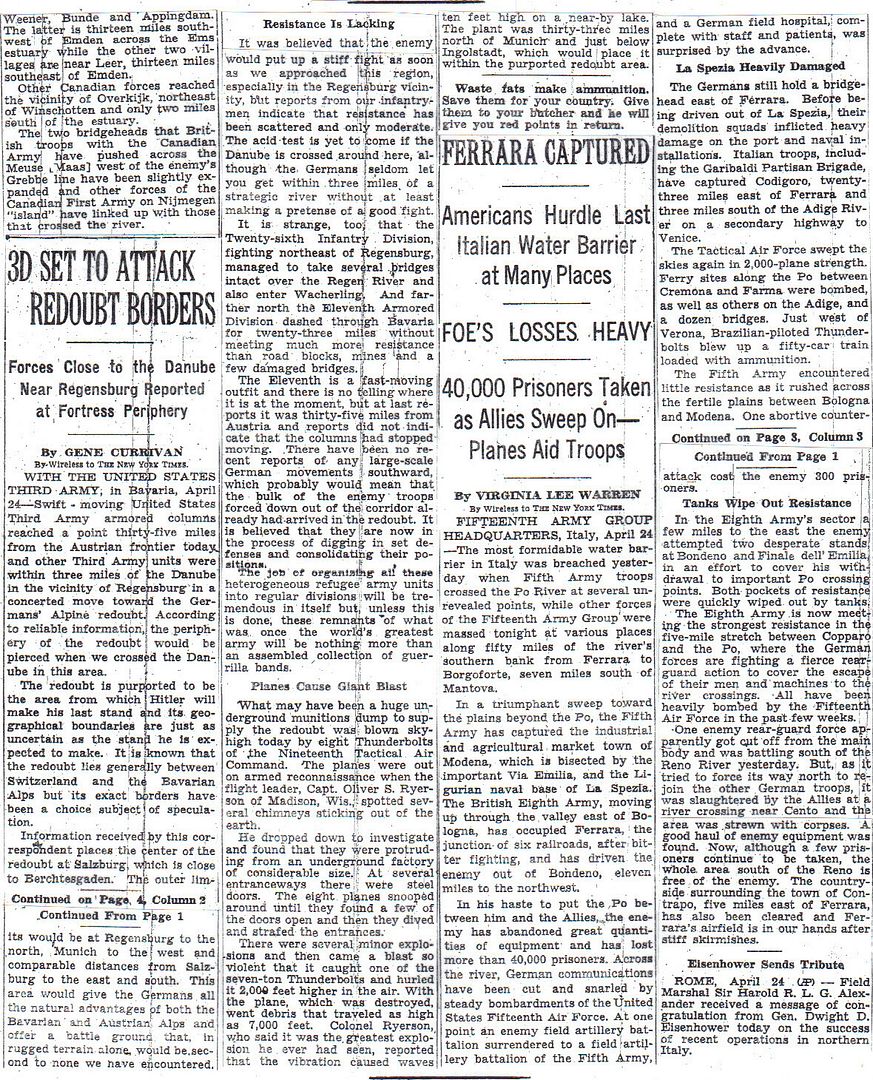
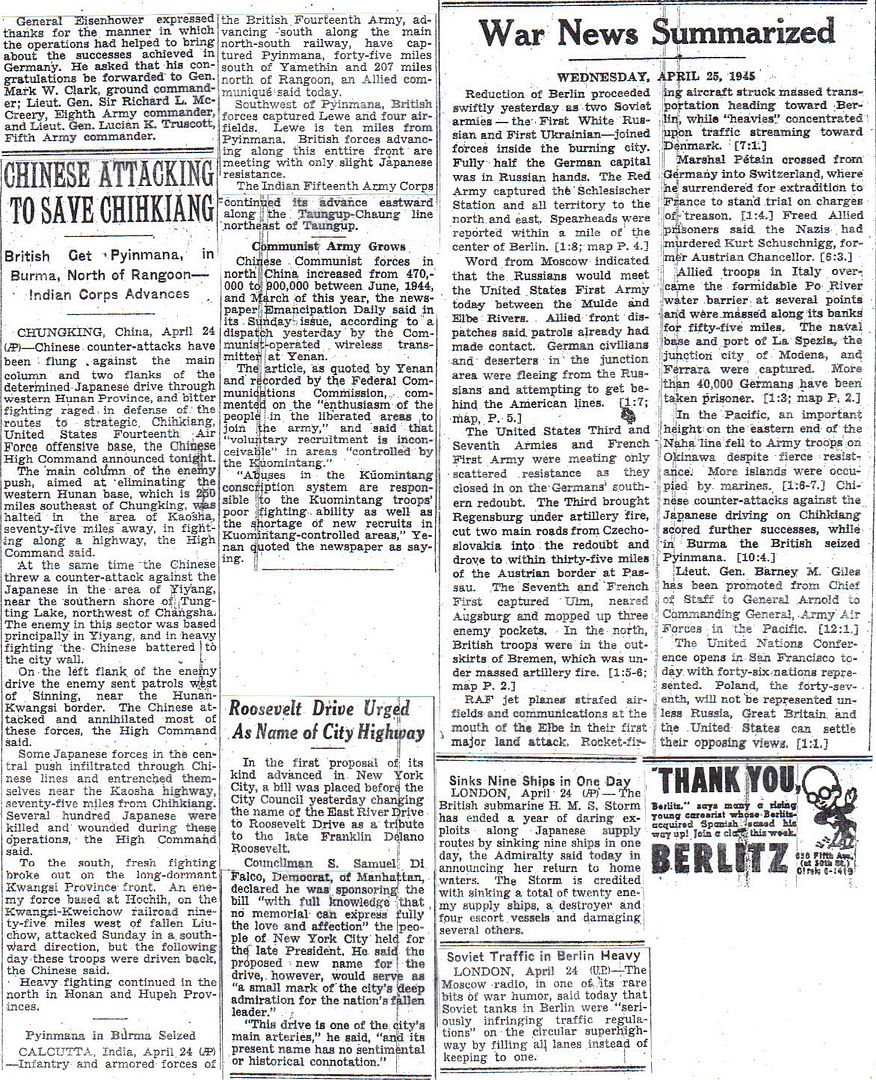
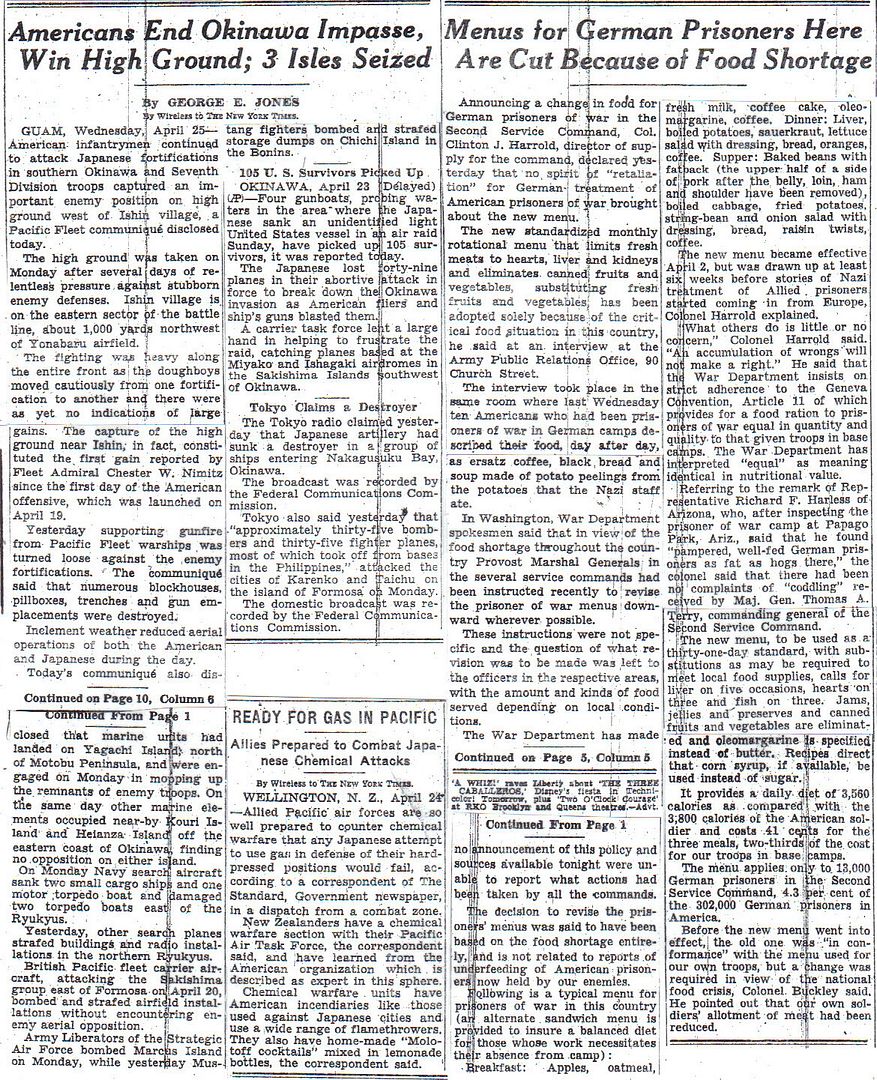

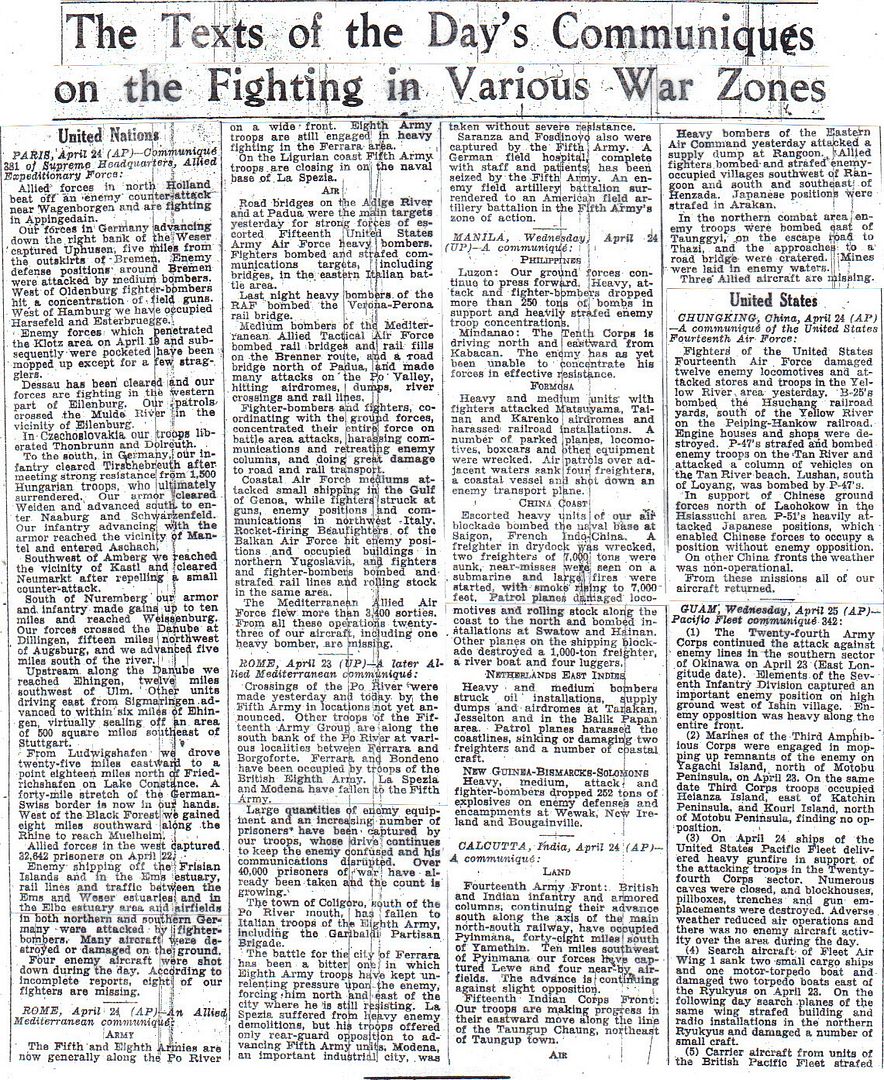
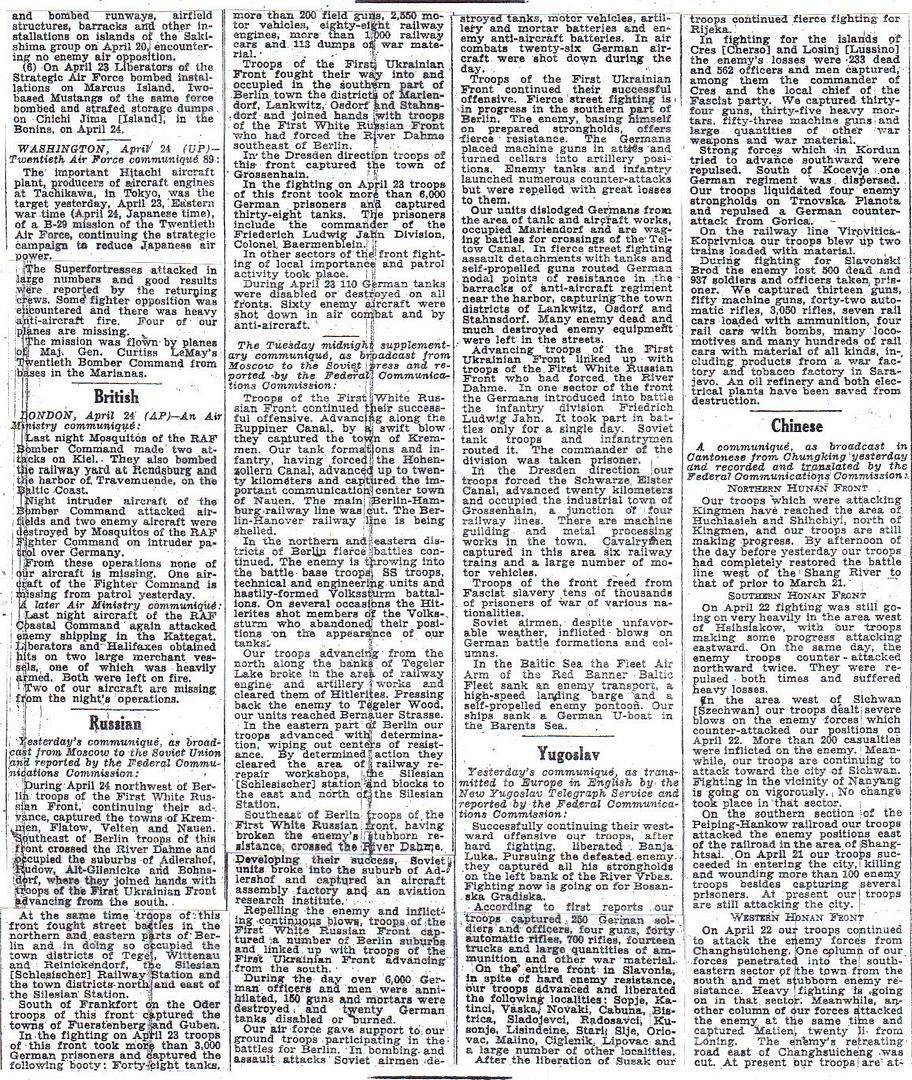

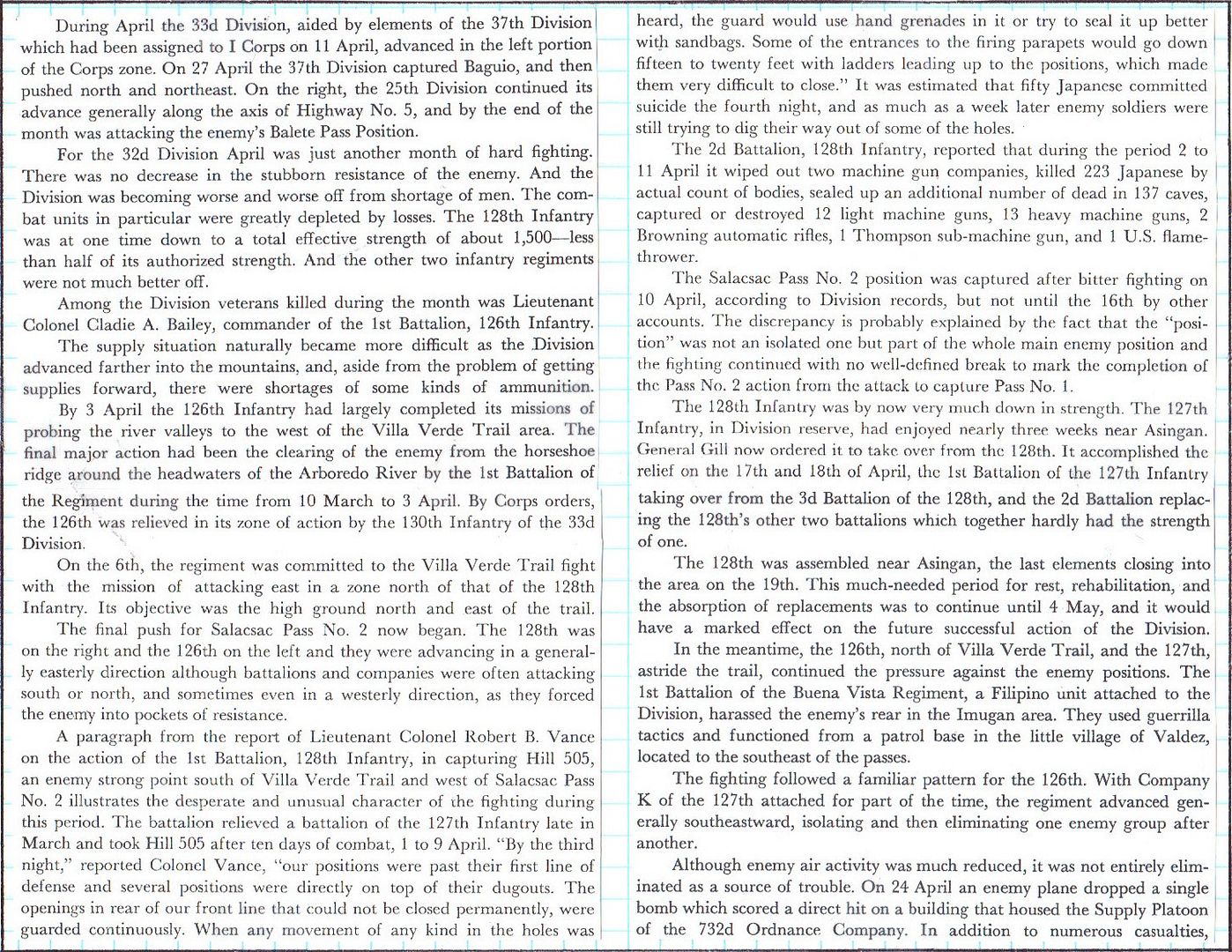
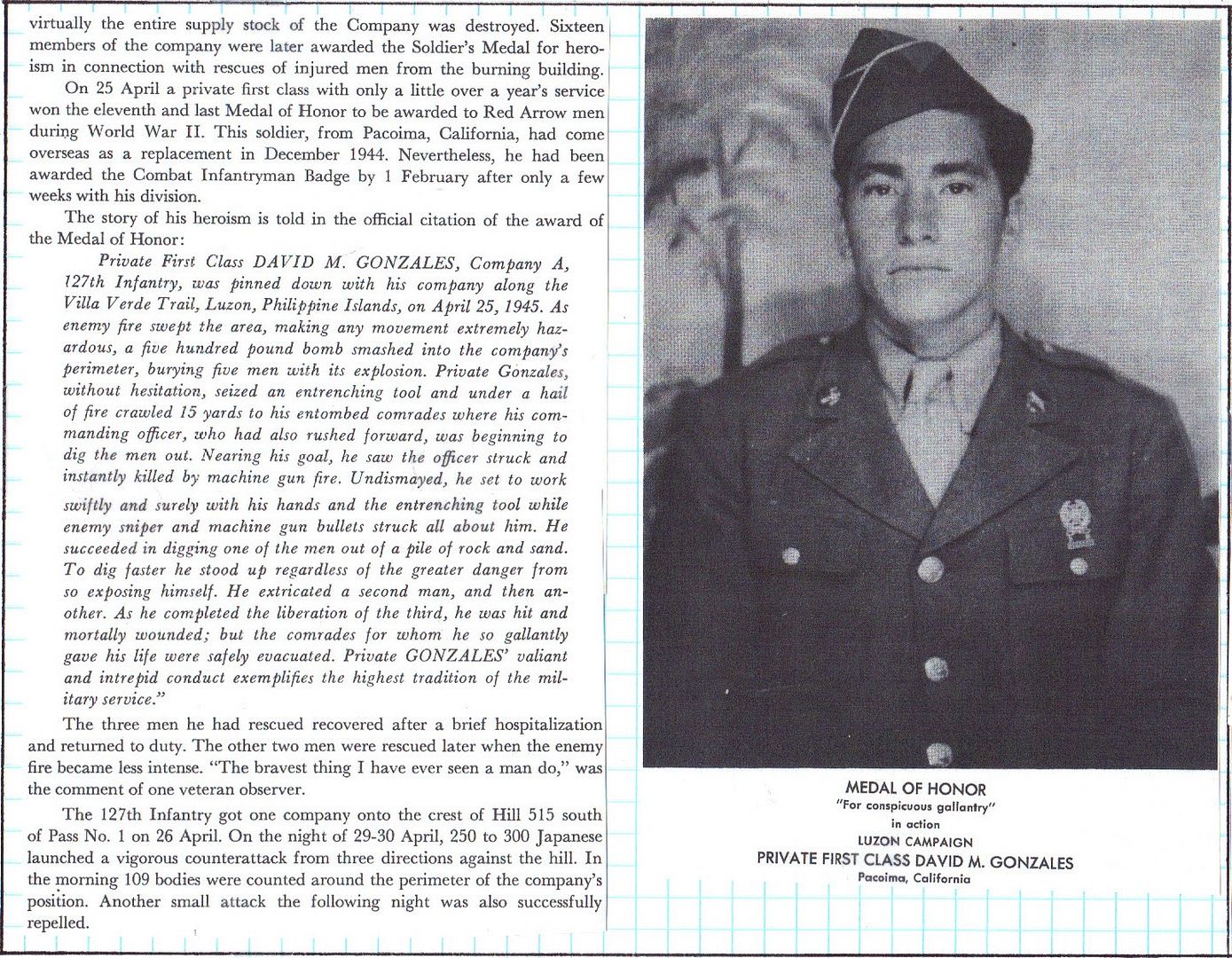
Major General H.W. Blakeley, USA, Ret., 32d Infantry Division World War II
* This looks like a photo of a drawing to me – HJS.
http://www.etherit.co.uk/month/3/25.htm
April 25th, 1945
UNITED KINGDOM: The US 8th Air Force makes its last bombing mission from England when 554 B-17s and B-24s attack airfields and rail targets in Czechoslovakia and south-eastern Germany.
The fighter groups including the 78th fly their last combat missions.
GERMANY: The Soviets complete the encirclement of Berlin. Zhukov’s tanks, sweeping across the northern suburbs, have cut all the roads leading to the west and yesterday linked up with Konev’s drive from the south at Ketzin. Inside the city, government buildings in the Wilhelmstraße are under point-blank fire from field guns.
Pillam in East Prussia falls to the Russians.
The US 1st Army meets the Soviet Army at Torgau on the River Elbe.
375 RAF Lancaster and Mosquito bombers drop six-ton bombs on Hitler’s home at Berchtesgaden. Escorted by 98 Mustangs of the US Eighth Army Air Force and 13 Mustang squadrons of RAF Fighter Command, the bombers flew low, taking cover from the anti-aircraft fire behind mountains, until they were almost over the target, and then dropped their bombs. The Times reported on the attack that twelve 1,000-lb bombs, fused for deep penetration, were used against the Berghof chalet, and large numbers of 4,000-lb and 1,000-lb bombs were dropped on the SS barracks. After the second run, and with two Lancasters missing, the anti-aircraft batteries had been silenced. When it was all over, most of the buildings on the Obersalzburg were smoking ruins. (Russell Folsom)(128)
U-1197 damaged by bombs at Bremen and stricken at Wesermünde, 25 Apr 1945. Captured there by British forces.
NORWAY: Tonight an oil target at Vallo is the subject of the last raid by RAF Lancasters of the war. (22)
FINLAND: The last German troops leave Finnish territory around Kilpisjärvi, in far north-western Finland, thus ending the Fenno-German Lappland War and WWII for Finland. In this last day, two Finnish soldiers die, one is wounded and one goes missing in skirmishes with German patrols. During the seven-month war against Germany, Finns lose 774 KIA, 262 MIA and 2904 WIA. The German losses are estimated roughly equal.
ARCTIC OCEAN: Destroyers HMS Iroquois, Haida and Huron arrive Kola Inlet with Convoy JW-66.
ITALY: German resistance begins to collapse as Mantua, Parma and Verona fall to the Allies. Just 40 miles away, Mussolini flees to Como.
Uprisings in Milan and Genoa are aided by Partisans.
PACIFIC OCEAN: PB4Y-2 Privateers of Patrol Bombing Squadron One Hundred Eighteen (VPB-118) based at Yonton, Okinawa, continue sewing aerial mines off the coast of Korea.
U.S.A.: An Allied conference at San Francisco meets to write a constitution for the post war organization “The United Nations”. The meeting will conclude tomorrow.
US Secretary of War Stimson and General Leslie Groves arrive at the White House. They are here to brief President Truman on the Manhattan Project — “S1” as Stimson preferred to call it.
Stimson meets alone with Truman at first. A memo of several pages, was given to Truman. Finished by Stimson that morning, it begins: “Within four months we shall in all probability have completed the most terrible weapon ever known in human history, one bomb of which could destroy a whole city.” The memo acknowledges the shared development, by the US and Great Britain, of this “most terrible weapon”.
General Groves then joins them with a memo of 25 pages on the status of the Manhattan Project. After President Truman reads this, Stimson and Groves answer his questions.
Stimson asked for an authorization to establish an advisory committee to “advise” the President regarding the implications and decisions of “this new force”. The request is approved.
This is Truman’s first briefing of specific activities at Hanford, Washington and other locations within the US. Truman had first become aware of the huge government activity during 1943 as Chairman of the “Truman Committee”. At that time, after assurances by Col. Stimson, he kept the committee away from any serious investigations of the Manhattan Project. (From David McCullough “Truman”)
During the organising conference USS CASPER makes two security patrols off the Farallon Islands.
Destroyer USS Hamner laid down.
Submarine USS Unicorn laid down.
Minesweeper USS Embattle commissioned.
ATLANTIC OCEAN: U-326 sunk in the Bay of Biscay west of Brest in position 48.12N, 05.42W by a homing torpedo from a USN VPB-103 Sqn Liberator. 43 dead (all hands lost).
It was around this day that Hitler realized he was going to lose the war and he gave his speech to his remaining generals in an underground bunker, which 65 years later would become an internet meme (lifted from the movie “Downfall”)
http://www.nuclearfiles.org/menu/library/correspondence/stimson-henry/corr_stimson_1945-04-25.htm#
“”Memorandum on Sharing Nuclear technology
From: Henry Stimson, Secretary of War
To: Harry S Truman, President of the United States of America
Date: April 25, 1945
Memorandum discussed with the President
April 25, 1945
1. Within four months we shall in all probability have completed the most terrible weapon ever known in human history, one bomb of which could destroy a whole city.
2. Although we have shared its development with the UK, physically the US is at present in the position of controlling the resources with which to construct and use it and no other nation could reach this position for some years.
3. Nevertheless it is practically certain that we could not remain in this position indefinitely.
a. Various segments of its discovery and production are widely known among many scientists in many countries, although few scientists are now acquainted with the whole process which we have developed.
b. Although its construction under present methods requires great scientific and industrial effort and raw materials, which are temporarily mainly within the possession and knowledge of US and UK, it is extremely probable that much easier and cheaper methods of production will be discovered by scientists in the future, together with the use of materials of much wider distribution. As a result, it is extremely probable that the future will make it possible to be constructed by smaller nations or even groups, or at least by a large nation in a much shorter time.
4. As a result, it is indicated that the future may see a time when such a weapon may be constructed in secret and used suddenly and effectively with devastating power by a willful nation or group against an unsuspecting nation or group of much greater size and material power. With its aid even a very powerful unsuspecting nation might be conquered within a very few days by a very much smaller one, although probably the only nation which could enter into production within the next few years is Russia.
5. The world in its present state of moral advancement compared with its technical development would be eventually at the mercy of such a weapon. In other words, modern civilization might be completely destroyed.
6. To approach any world peace organization [the United Nations] of any pattern now likely to be considered, without an appreciation by the leaders of our country of the power of this new weapon, would seem to be unrealistic. No system of control heretofore considered would be adequate to control this menace. Both inside any particular country and between the nations of the world, the control of this weapon will undoubtedly be a matter of the greatest difficulty and would involve such thorough-going rights of inspection and internal controls as we have never heretofore contemplated.
7. Furthermore, in the light of our present position with reference to this weapon, the question of sharing it with other nations and, if so shared, upon what terms, becomes a primary question of our foreign relations. Also our leadership in the war and in the development of this weapon has placed a certain moral responsibility upon us which we cannot shirk without very serious responsibility for any disaster to civilization which it would further.
8. On the other hand, if the problem of the proper use of this weapon can be solved, we would have the opportunity to bring the world into a pattern in which the peace of the world and our civilization can be saved.
9. As stated in General Groves’ report, steps are under way looking towards the establishment of a select committee of particular qualifications for recommending action to the Executive and legislative branches of our government when secrecy is no longer in full effect. The committee would also recommend the actions to be taken by the War Department prior to that time in anticipation of the postwar problems. All recommendations would of course be first submitted to the President. [Truman agreed to the formation of this committee, which would be called the Interim Committee]
Source: Michael B. Stoff, ed., The Manhattan Project: A Documentary Introduction to the Atomic Age (Philadelphia: Temple University Press, 1991), pp. 95-96.””
"Lice and fleas were among the banes of existence for concentration-camp inmates.
Not only did these vermin make camp life even more unbearable, but they also carried disease.
Hence, the Allies made a concerted effort to help former prisoners to end infestations.
Here, an American soldier disinfects survivors of the Flossenbürg, Germany, camp."
"The diets that camp inmates received had profound long-term effects upon their digestive systems.
Among the results of prolonged malnutrition were severe cases of dysentery, many of which proved fatal even after liberation.
Here, a young Czech man suffering from a serious case of the disease is helped by two other survivors of the Flossenbürg camp."
See April 22 , reply #4.
Ninth Army in the Beeskow Pocket southeast of Berlin:
Twelfth Army ordered to "relieve" Berlin:
Berlin:
There is one last map in the archives, for April 30. I suspect that is the last map that was prepared, as there was no way to report on the situation outside Berlin after that. I may do a side by side comparison of map crops for April 25 and the 30th to show the changed situation.
These terrible weapons will be displayed to the world in actual use in a few months. And for at least the next 70 years, not used again.
They did change the world.
This is either an indictment of the poor technological state of Soviet photography, or a testament to their skill in making people "disappear" from official photographs.
I guess that makes the Times front page image a radiophoto of a drawing of a photo. And what I posted was an image of a photocopy of a microfilmed photo of a . . .
April 25, 1945 | Conference to Form U.N. Meets as Allied Forces Near Victory Over Nazis
On April 25, 1945, in San Francisco, 46 nations met to discuss the creation of the United Nations, an international organization intended to maintain peace between nations. The conference began as troops from the United States and Soviet Union linked up on the Elbe River, in central Europe, a meeting that dramatized the collapse of Nazi Germany and the end of World War II in Europe.
The main stories in the April 25 edition of The New York Times told of the Allied success in Germany. One article described the atmosphere in San Francisco, where international leaders were preparing to “meet in the Opera House tomorrow to organize the peace which they have fought so hard to win.”
The main issue surrounding the conference was the participation of Poland, which had no representation because of a dispute between the “Big Three” Allied countries over whether to recognize the London-based Polish government-in-exile or the Warsaw-based provisional government. Poland would not take part in the San Francisco Conference, which lasted two months and eventually included 50 countries.
The leaders at the conference confirmed the organization of the United Nations and drafted the U.N. Charter. The most contentious issue was the veto power of the Security Council, which was debated by the United States and the Soviet Union. The issue was settled when American leaders reached out directly to the Soviet leader Josef Stalin. The conference concluded with the unanimous approval of the charter on June 26, by which time the war in Europe had ended.
The Times reported on the events of April 25 in Germany in its April 28 edition. The war correspondent Drew Middleton wrote, “Two armies of plain men who had marched and fought from the blood-splashed beaches of Normandy and the shattered streets of Stalingrad have met on the Elbe River in the heart of Germany, splitting the Third Reich and sealing the doom of the German Army, whose tread shook the world only three short years ago.”
On April 30, Adolf Hitler was said to have committed suicide in his bunker in Berlin as Allied forces took control of the German capital. His successor as head of the Nazis, Karl Dönitz, immediately began to negotiate a surrender. The Nazis formally surrendered on May 8.
Sounds like the dinner party at the Berchtesgaden and the post meal frolicking has been canceled for the evening...
http://www.atlantic-times.com/archive_detail.php?recordID=185
“Treat them nicely”. Sixty years ago, U.S. forces and the Red Army met in Torgau, Germany. By Martin Herzog
“Who has ever heard of Torgau,” asked the Soviet daily, Pravda. “But now, this place has just gone down in history!” That is because it is the small town on the Elbe River where U.S. forces and the Red Army met for the first time since becoming allies and uniting in the fight against Nazi Germany. The meeting was expected to take place, but the way it happened on April 25, 1945, was not at all planned.
He should not be here. He should have turned around several miles ago. The orders were clear: Patrol the Mulde River; check for refugees who are coming in from the East in large numbers; then return to the command post in Trebsen. Patrol activity was not allowed more than five miles east of the river. But now, Lt. Bill Robertson of the 273th Regiment of the 69th Infantry Division is driving his army jeep further east toward the Elbe River, accompanied by three of his comrades and equipped with only a single machine gun on top.
Robertson’s patrol passes through small deserted villages. Outside of Torgau, they hear about a prison camp holding American soldiers. So they head into town, hoping to liberate their comrades - And, hey, why not go down in history? Why not be the first ones to encounter Soviet troops?
For this had been the main topic of the day: Who would be first? What would it be like? And what would they be like, those Russians: brothers in arms, yes, but strangers, anyway.
When asked how to deal with the Russians on this occasion, Gen. Hodges, Commander of the First U.S. Army, simply replied: “Treat them nicely.” All patrols were given orders not to communicate with the press in case of an encounter but to report back immediately. The plan was to publish the event simultaneously in Washington, London and Moscow.
Everything was very well organized. When the “Big Three” - Churchill, Roosevelt and Stalin - met in Yalta on the Crimean Peninsula three months earlier, they not only discussed the future world order. Their military also agreed on several security procedures to avoid friendly fire when the armies met: carrying clear symbols of identity, for one, or firing different colored star shells as a sign of recognition: green for the Americans, red for the Russians.
Robertson and his small patrol are anything but prepared for this encounter. They have no radio to report contact; they do not have any star shells to fire - no green, no red, none at all. They do not even have a decent flag. On their way, they force a civilian to hand them a white bed sheet. They tear a big piece out of it and store it in their jeep. A white flag is perhaps not appropriate, but better than arriving empty-handed, thinks Robertson.
Torgau is deserted. The Wehrmacht left the place only a few hours before. Only a few dozen civilians remained in the town. Robertson’s party stops at the prison camp, situated in an old fortress, where they find 40 men. But there is not much time to celebrate: they hear gunfire ringing from the Elbe River and head toward the riverbank.
On the way, a German civilian tells them that the Russians have already arrived on the east bank of the river. This is their chance! But then there is an ambush; a sniper fires at them. They scatter. Is it the Russians? Did they not recognize them? They have to make sure they are identifiable as Americans. Robertson decides to break into a nearby drugstore. They tint the white sheet with red stripes and a blue rectangular spot in the upper left corner. It’s not quite the star-spangled banner, but it will serve the purpose, thinks Robertson. Afterwards, he looks for a high building or a tower near the riverbank.
***
Somebody is waving a dirty cloth. Lt. Alexander Sylvashko can see him through his binoculars. The man waving the cloth is just a hundred meters away in the window of a nearby tower and he seems to be yelling, too. But what is he saying? Sylvashko is skeptical: “I thought it was another provocation by the Germans dressed in civilian clothes,” the 84-year-old Sylvashko remembers 60 years later. “They had shown up in the morning on the other side of the river with white armlets and signs of surrender. When we signaled to them to come over they started firing at us - and we shot back, of course.”
“It was a warm sunny day, this April afternoon,” Sylvashko recalls. “Lilacs were blossoming on the river bank.” One would, however, think he was too busy to notice the beauty of the landscape. When they had arrived that morning, the Germans shelled his platoon. So, they used their artillery to drive them out of Torgau and fought the remains of the German resistance. All bridges across the Elbe were destroyed, blown up by the retreating German forces. Right in front of them, scattered bricks and steel beams from a crumbled bridge stuck out of the high, roaring water. It was hard to cross and Sylvashko did not even try. He had orders to halt at this position east of the river as the U.S. forces and the Red Army had agreed to this procedure a few days earlier. So, Sylvashko had his men dig trenches. Then they waited for the Americans to show up.
But who is this idiot on top of a tower, waving some kind of flag, yelling something like “Amerikanski!” Are these supposed to be the Americans? Sylvashko has never seen one before; neither has any of his platoon. He gives the order to fire a red star shell, the signal of recognition. He waits a couple of minutes: no answer. “No green star shell - no Americans,” Sylvashko thinks. “It seemed like another SS trick. I ordered a 45 millimeter gun to fire at the tower.” Two shells hit close to the spot where the flag waver stood. The man is gone and there is silence. Another two minutes pass. “Then there were four soldiers coming up the bridge, dressed in uniforms we had never seen before. They brought along a Russian prisoner who shouted ‘we are Americans! Don’t shoot!’ “
***
So, here they are, the first Russian soldiers to meet the first American soldiers on enemy ground. United by having defeated the German aggression - but still divided by the Elbe. Robertson waves at them and Sylvashko waves back. They have to crawl on their hands and knees across the crushed rocks to get to each other. Andrejew, one of Sylvashko’s men, goes first, while he himself backs up the others. Robertson and Andrejew meet exactly in the middle of the collapsed bridge, on a steel bar, shaped like a “V.” What a symbol! It is pretty instable, so they just pat each other’s shoulders, both grinning, both not knowing what to say.
It is 4 p.m. on April 25, 1945: “The war is over! This was the feeling we all shared at this moment,” says Sylvashko. Shortly afterwards they all stand on the east bank of the Elbe and shake hands and embrace and scream at each other out of relief: “We did not understand the words of the Americans and they could not understand us, but that did not matter. Somehow we got the messages across.”
More Russian soldiers show up. Suddenly there are food and drinks: Canned fish, cookies, chocolate, wine and schnapps. Russian soldiers and GIs embrace and exchange medals and souvenirs. But the party does not last very long. Sylvashko reports back to his superiors and Robertson needs to return to headquarters. He invites Sylvashko to come along - as living evidence of his encounter. Sylvashko agrees and joins Robertson’s patrol with two other men from his platoon - although they still do not really trust their allies. “We were skeptical,” Sylvashko said. “We believed their headquarters to be very close to our position, but the ride did not seem to end. We even thought they might be bringing us there as prisoners for interrogation. In such a case, we had orders to defend ourselves to the last round. But as it turned out, that was not necessary.”
***
“Robertson has brought an unusual load,” voices ring across the command post in Wurzen when they arrive. At the camp they think the patrol has brought back some drunken Russian workers. When they realize that Robertson has actually made first contact, the group is immediately sent to the regiment’s headquarters in Trebson and then to the division’s staff in Naunhof where a big welcoming party receives the Russians. For Robertson and his men, the welcome is much less warmhearted: his superiors are not at all amused that he disobeyed orders and Robertson is brought to detention. He is told that he will be court-martialed. But when word finally reaches Gen. Hodges, the commander of the First U.S. Army is pleased to hear about the successful contact and congratulates - not Robertson, of course - but his superior.
Anyway, in the end Robertson is pardoned. Both he and Sylvashko are presented to the waiting press and an official meeting is planned for the next morning. It’s already well past midnight when the party returns to the command post in Trebsen. “There we had a late dinner,” recalls Sylvashko, “and without noticing it, it turned into an early breakfast.”
At dawn on April 26, an overtired Lt. Robertson is on his way to Torgau once again, this time not only accompanied by his new Russian friends, but also leading a platoon of 13 other jeeps. They return to the bridge where they had met the day before and more soldiers from both sides join in.
One of them is Delbert E. Philpott. For the soldiers, it’s just a big party. “It was a big relief,” Philpott recalls. “ ‘We live to go home’ - was our common feeling. We were not really aware of the historical meaning of the day. But we were released from the tension that there is always someone in front of you waiting to kill you.”
The international press also arrived. Official pictures were taken. “Everybody who owned a camera was shooting pictures all the time while we were hugging and kissing,” Philpott said.
Allan Jackson, a press photographer asks Philpott and some other soldiers to pose for a picture on the ruined bridge while shaking hands. “This picture was just one of the many taken on this day,” Philpott said. “So we just did what he wanted and went on celebrating afterward. Nobody gave it a second thought. And we never expected it to be published, for we were just ordinary soldiers.”
But this is the photo that appears on the front page of The New York Times and several London newspapers only a few days later. It becomes one of the most symbolic and most reprinted photos of World War II, even though nobody on it was a member of the original party. For years, Philpott does not know anything about the photo’s popularity. He only recognizes his own face decades later when studying an encyclopedia about the event.
***
The residents of Torgau do not know anything about this historical meeting. Manfred Bräunlich, who at the time was 16 years old, served as one of the town’s young voluntary fire fighters. They stayed until almost the end to fight fires started by the bombardment. “We were happy that we could stay,” says Bräunlich today. “And I was happy that I did not have to join the Wehrmacht during those last days of the war. We knew that these were the last weeks of the fight - we listened to BBC every night, although this was strictly forbidden.” But the day before Robertson’s patrol arrived, they had to leave, too. They returned two days later to a quiet Torgau. The celebrations were already over. Both the American and the Russian army had moved on. Only occupation troops patrol the streets. The war is over. Only much later do they learn that their town became a historic place on this day.
And what about Robertson? He becomes a war hero. Sylvashko does not. In the Red Army, being a historic figure does not entitle you to mercy. He also disobeyed orders: he was not allowed to cross the river. Two of his superiors are demobilized from the army, sent home and excluded from the Communist Party. Members of the NKVD, the predecessor to the KGB, interrogate Sylvashko. Since he is young and of low rank, he is soon released.
Today, Sylvashko says: “Like Robertson, we were of the lower ranks and followed a patriotic impulse, and we were incidentally at the place of a historic meeting.” Shortly after the end of the war against Germany, the Cold War started. It was not until 30 years later that the two veterans would meet again to commemorate the well-planned, yet chaotic events in Torgau at the end of April 1945.
P.S.: There was another U.S. patrol that was sent out on this day, just a few miles down from Torgau. They actually had contact with the Russians before Robertson’s patrol, but their radio message was misunderstood and their position recognized only 24 hours later. Just for the record: Kotzebue was the name of the patrol leader.
- Radio journalist Martin Herzog, a native of the Rhine region, specializes in historical writing and works for such radio stations as WDR, Germany’s largest public radio broadcaster.
Disclaimer: Opinions posted on Free Republic are those of the individual posters and do not necessarily represent the opinion of Free Republic or its management. All materials posted herein are protected by copyright law and the exemption for fair use of copyrighted works.